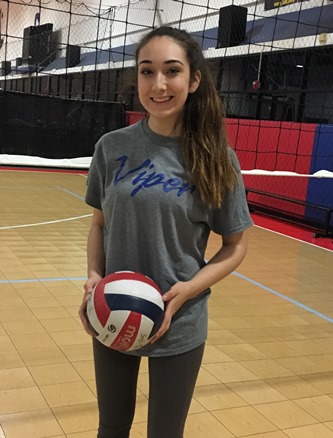
Thanks to surgery by Dr. V. Salil Upasani for hip dyplasia and femoral anteversion, Aria is pain-free. After recovering from her final surgery, she’ll be back on the volleyball court.
By Sharyn Rosenbaum
Aria Ybarra lives and breathes volleyball. She started playing at age 6 and joined a Club team at age 10, where she played competitively. In October, she began playing for the Viper Volleyball club in Temecula on its top team, shortly after starting eighth grade. Just seven months earlier, she was on the operating table at Rady Children’s Hospital-San Diego having her first surgery for a painful hip condition. A second surgery, on her other hip, was performed three months later.
Gone is the pain she was trying to cope with. “I’ve had no pain in my hips,” Aria says. “I can’t feel anything.”
Two years ago, Aria was diagnosed with hip dysplasia in both hips, an abnormal formation of the hip socket that causes the hip joint to become partially or completely dislocated. Much earlier in her life, when she started walking, she was diagnosed with another orthopedic condition called femoral anteversion, an inward twisting of the thigh bone that causes the knees and feet to turn inward. Surgery was needed to correct both issues.
Aria could have had the hip surgery right away, when she was 12, but as her bones were still growing, a full body cast was required. So the family decided she should wait. “We waited until she started complaining of hip pain,” mom Chantae Ybarra says. “We thought it might be growing pains or that she was training too hard, but then she said, ‘I can’t even really move my leg to get dressed in the morning.’”
The first surgery for her hip dysplasia and femoral anteversion was scheduled for this past spring, on March 27. The same surgery on the left side occurred on June 17. They were performed by V. Salil Upasani, M.D.
For her hip dysplasia, Dr. Upasani performed a periacetabular osteotomy, or PAO, which involves cutting the pelvis at specific points and putting the hip socket in place with screws. Unlike a total hip replacement, the procedure gives patients a higher chance of resuming vigorous activities, like volleyball. For her femoral anteversion, he performed a femoral osteotomy, which involves cutting the bone in order to realign the femur. A third procedure will be done on Nov. 4 to remove Aria’s hip implants. “Her implants are being removed because her bones have healed and they are no longer necessary,” Dr. Upasani explains.
Aria is thrilled with the outcome, saying that her legs are “really straight now.” Along with being grateful for Dr. Upasani’s surgical skills, the family also values the time and attention he gave them. “We really appreciated that he checked in on her on Father’s Day,” Chantae says. “We never felt rushed with him, and he has a great bedside manner.” Aria adds that the nurses were right by her bedside the entire time she was in the Hospital and describes the entire staff on the floor as “so amazing and accommodating.”
Four weeks after the second surgery, Aria started rehabilitation, doing squats, walking on the treadmill and using resistance bands. She worked hard to get her legs back in shape for volleyball.
The 14-year-old starts high school next year and hopes to make the team. She is setting her sights on playing college ball as well.
Published Fall 2016